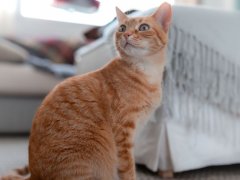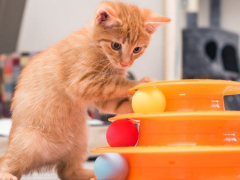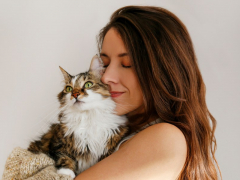
Vectra is a brand of topical, “spot-on” flea treatment and prevention product manufactured by Ceva Animal Health. In this article, you’ll learn what Vectra is, its active ingredients and how they work, the parasites it targets, adverse effects to watch for, and some frequently asked questions.
Vectra for Cats & Kittens Overview

About Vectra for Cats

Vectra for cats contains the two ingredients dinotefuran and pyriproxyfen.
Dinotefuran is a nitroguanidine neonicotinoid insecticide. It binds to the neurotransmitter acetylcholine receptor on target insects leading to overstimulation. This causes tremors, incoordination, and death of the insect. It’s important to note that dinotefuran only binds to insect acetylcholine sites, and not to similar feline receptor sites.
Pyriproxyfen acts as an insect growth regulator. By mimicking and pretending to be insect juvenile growth hormone, it halts development of flea larvae. It also leads to a female flea producing non-viable eggs that cannot hatch.
Spot-on products like Vectra are applied to the surface of a small target area or “spot” of the skin, usually at the back of the head or neck.
Medication collects in the oils of the skin and hair, allowing for continual release, lending to a 30 day period of efficacy. For many topical products, it takes about 24 hours to spread throughout surface oils on skin and hair to provide complete protection.
It is important to note that while these pesky pests are affected by Vectra by coming in contact with the skin and don’t have to actually bite a kitty to die, Vectra products do not provide true repellency that would prevent fleas from coming in contact with a pet.
What Does Vectra Do for Cats?
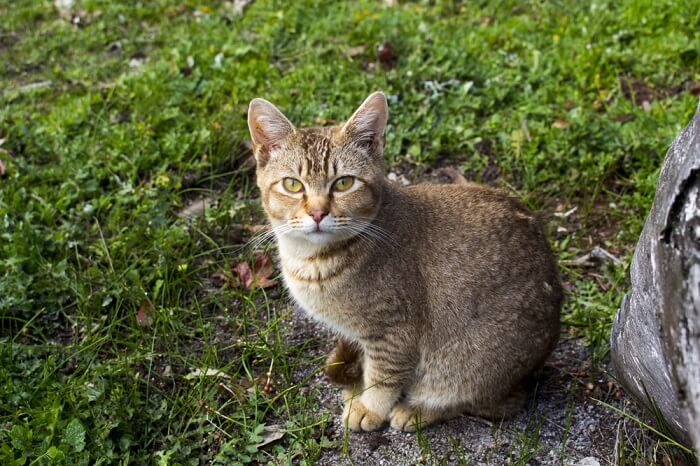
According to the manufacturer, Vectra is fast-acting for flea control, killing fleas quickly within six hours. The addition of the pyriproxyfen prevents continued reproduction and continuance of the flea life cycle. This eliminates re-infestation, as long as the product is continually used on a monthly basis.
It’s important to note here that Vectra only has activity against fleas and does not kill ticks, intestinal parasites, or mosquito-borne heartworms.
Vectra is quick-drying. Reportedly, bathing or swimming may not interfere with its action. However, generally, it’s an accepted practice to avoid bathing 24 hours prior to or 48 hours following the application of a product like Vectra.
Side Effects of Vectra for Cats
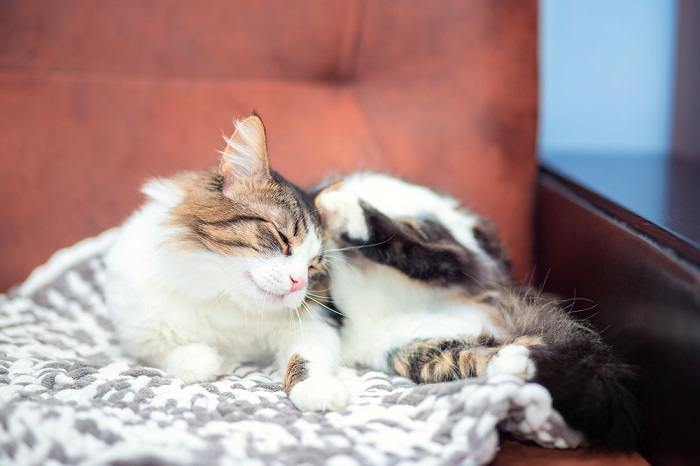
Monthly use of Vectra kills fleas and interrupts the flea life cycle to prevent new flea eggs from hatching.
According to the manufacturer, most adverse effects may be related to irritation at the application site, including redness, itching, and scratching. If you notice these effects in your cat after applying the product, the manufacturer recommends bathing with a mild soap or shampoo and rinsing with large amounts of water.
The manufacturer notes that gastrointestinal signs like vomiting and diarrhea have also been reported.
Both ingredients currently found in Vectra for Cats (dinotefuran, pyriproxyfen) generally appear to have a low potential for toxicity both topically and even if accidentally ingested.
However, most topical flea products are very bitter tasting. If a kitty were to lick off recently applied Vectra, either from themselves or a housemate, the bitter taste alone can lead to excessive drooling, agitation, and sometimes even vomiting.
According to DVM360, this effect is typically not a true toxicity, but a sometimes dramatic reaction to the bitter taste. Providing milk or liquid from a can of tuna can help resolve the signs in short order.
To avoid this from happening, it is important to apply any topical flea/tick product to the skin in front of the shoulder blades at the back of the neck, a location even the most flexible cat cannot reach to lick. In multiple cat households where lots of co-grooming occurs, it may be advisable to separate housemate kitties for up to 24 hours after application to allow the product to fully dry.
Using Caution With Other Flea/Tick Products
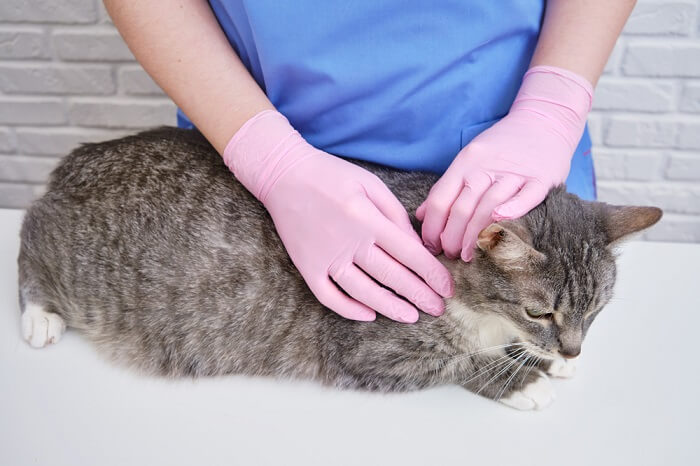
There is a very similar product for dogs called Vectra 3D. It is extremely important to never use this product on a cat.
Vectra 3D does contain two of the same ingredients as Vectra for Cats (dinotefuran and pyriproxyfen), but it also contains permethrin, which is very toxic to cats.
Fortunately, the Vectra 3D products do include a warning against use in cats on the front of the box.
But as a general guideline and just to be safe, when selecting a flea/tick product for your kitty, always make sure the product includes a picture of a cat and indicates the product is specifically for cats. This is now a requirement manufacturers have to follow to reduce the chance of mistaken product identity.
If possible, avoid use of any permethrin product on your dog at home if you have one cohabitating with your kitty.
If you must use a permethrin product and you have a pup and kitty who like to hang out together or groom each other, make sure to separate them for 24 to 48 hours after applying a topical product to your dog.
If you have any concerns for potential toxicity, even if you think your kitty might have just licked some Vectra off her own fur and is having a bitter taste reaction, it is always best to contact your veterinarian, the ASPCA Animal Poison Control Center (1-888-426-4435), or Pet Poison Helpline (1-855-764-7661) immediately for further advice.
And lastly, topical products like Vectra have been known to cause skin and eye irritation in people. It is best to avoid contact with the solution during application and to wash your hands after.
Vectra for Cats Dosage

Apply Vectra to the skin in front of the shoulder blades at the back of the neck where your cat cannot lick it off.
Vectra products are typically applied every 30 days for the best protection.
Vectra comes in two sizes for kitties. The first is Vectra for Cats and Kittens, which is indicated for felines weighing 2 to 9 pounds and at least 8 weeks of age or older. The second is Vectra for Cats, which is indicated for kitties weighing over 9 pounds.
Always follow all instructions on the packaging for any topical product you use for your kitty. Vectra vials come with a very narrow applicator tip with a small discoid base. Below the discoid base is another, larger, disc. To activate the vial, push the small disc at the base of the tip down so that it is in contact with the larger disc below it.
Vectra is then best applied as a topical treatment by parting the fur and applying to the skin along the back of the neck in front of the shoulders where a kitty cannot reach to lick it off.
Again, while Vectra reportedly is fast-drying and not affected by bathing, it’s still advisable to make sure not to bathe your kitty for 24 hours before and 48 hours after an application of any topical product. Bathing shortly before application may reduce its effectiveness.
If for some reason you are unsure if the product was administered correctly or whether all of it was applied, it is usually safest to not apply an additional dose.
If you have any questions about application or safety for Vectra products or any topical product, make sure to get in touch with your veterinarian.
Frequently Asked Questions
How effective is Vectra for Cats?
The ingredient combination of dinotefuran with pyriproxyfen is fairly effective with a pretty rapid kill time of about six hours against fleas.
The question of flea resistance to products like Revolution Plus and the idea that they don’t work comes up often. The 2017 article “Perception vs. Reality: Insecticide Resistance in Fleas” from DVM360 that refers to an article published in American Veterinarian that same year addresses this topic.
An entomology (“bug science”) professor from the University of California heavily investigated this question and concluded that while resistance has been seen to some flea treatment or prevention products, true chemical resistance in fleas with fipronil, imidacloprid, and some other newer products on the market has not yet been demonstrated.
In many cases, when a pup or kitty parent is still seeing live fleas on their pet after a product has been applied, this issue can most often be traced back to incorrect use or application of the product, as well as poor expectations.
Following are some common errors or misperceptions.
- Incorrect application (i.e., applied to the fur not the skin, failing to apply the whole volume of product, failure to properly puncture or open a vial prior to application)
- Failure to apply to all pets in the household. If one pet brings fleas indoors, they can jump onto all pets in the home. If all pets are not treated at the same time, flea infestations can persist.
- Bathing. Baths are a common go-to, especially when live fleas are seen. However, while waterproof, Revolution products need 24 hours to spread throughout the oils on the skin. Bathing shortly before or after application removes oils from the skin as well as possibly the product itself.
- Not treating long enough. It can sometimes take as long as three months to clear out a flea infestation. So while most veterinarians advise year-round protection against fleas and ticks, a product like Revolution Plus should be used every month for at least three months during an active infestation. Flea eggs not cleared from the home environment are likely to continue hatching every couple of weeks, meaning a kitty that received only one monthly dose of Revolution Plus can get infested again a few weeks later if the dose is not repeated the next month.
- Not treating year-round. Fleas have been known to over-winter indoors. Treating pets for only certain months of the year can leave open gaps in prevention for infestations to occur.
- Failing to treat the environment. Because one flea can lay up to 50 eggs in just one day, the amount of eggs in a home environment with fleas can be staggering. If the environment is not treated effectively, continually hatching fleas may continue to be found on a treated pet.
- Perceiving products as repellents. Always remember that most topical products like Revolution Plus do not have repellency action, meaning that fleas and ticks must come in contact with the skin to be killed. Heavily-infested outdoor areas as well as poorly-treated indoor infestations can be sources for large numbers of adult fleas to “suddenly” appear on a treated pet.
If you still feel there’s a true product Issue. If you feel you have applied a product properly and are addressing a flea infestation according to your vet’s instructions and still feel that a product is not working well, make sure to bring those concerns to your vet or contact the manufacturer of the product.
Is Vectra safe for cats?
The ingredients in Vectra for Cats are considered safe. Dinotefuran can only bind to insect acetylcholine receptors and not receptors in cats.
Similarly, pyriproxyfen’s action of mimicking insect juvenile growth hormone is an action that targets insects only, without having similar adverse effects on cats.
The most common type of adverse reaction cats show to topical products like Vectra is irritation at the site of application, which could occur with any similar product if a cat has sensitive skin.
As mentioned earlier in the article, it is very important to make sure the application site on the back of the neck near the base of the skull is where the product is actually applied. If the product is applied further down the neck or back and a cat licks it off, a bitter taste reaction consisting of drooling, nausea, or even vomiting may occur.
Which is better, Frontline or Vectra?
Based on kill time alone for fleas, Frontline has a faster onset of action. While Vectra can kill fleas within six hours, Frontline Plus can work within gour hours. The newer Frontline GOLD has the ability to start killing fleas within just 30 minutes.
Frontline products also have efficacy against ticks and mosquitoes as well, which Vectra does not.
How long does Vectra last on cats?
Like most topical flea/tick products, Vectra should be reapplied every 30 days for the best results. After 30 days, the drug is no longer present within the oils of the skin to provide protection.
While most veterinarians do recommend year-round use of a flea and/or tick prevention product, management of a current flea infestation may take at least three months of recurrent use of a product. This is because eggs still present in the environment prior to product use may still hatch and produce more adult fleas.
However, as long as the product continues to be used, those fleas will not be able to reproduce or hatch any more eggs, and will die quickly from the product, eventually ending the infestation.

